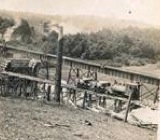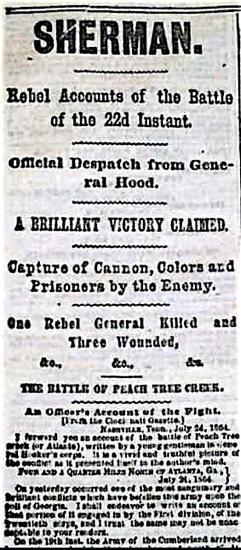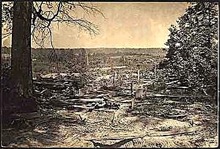






Peachtree Creek Crossing
Peachtree Creek and it’s tributaries run more than 60 miles from the edge of Gwinnett Co. through the heart of DeKalb and Fulton Counties.
Nancy Creek is one of the main tributaries that rises in Dunwoody and joins a mile before it hits the Chattahoochee River.


July 29, 1864 New York Herald
"Few battlefields of the war have been strewn so thickly with dead and wounded as they lay that evening around Collier's Mill."
(Union Major Gen. J. D. Cox )


On July 19, Hood learned that Sherman had split his army; Thomas's Army of the Cumberland was to advance directly towards Atlanta, while Maj. Gen. John M. Schofield’s Army of the ohio and Maj. Gen. James B. McPherson’s Army of the Tennessee moved several miles east, apparently an early premonition of Sherman's general strategy of cutting Confederate supply lines by destroying railroads to the east. Thomas would have to cross Peachtree Creek at several locations and would be vulnerable both while crossing and immediately after, before they could construct breastworks. In addition, Maj. Gen. william J. Hardee's corps would enjoy a rare three-to-one numerical advantage over the Union IV Corps. Hood thus hoped to drive Thomas west, further and further away from Schofield and McPherson, and Sherman would be forced to divert his forces away from Atlanta.
This advantage evaporated when the Confederates arrived late to their starting positions, to find the bulk of Thomas's command already on the south side of the Creek, and on prepared high ground. Hood nevertheless unleashed a frontal assault on the Union left, in the vicinity of Peachtree Street, and the Confederates were forced into rolling down the Union lines under enfilade fire. At one point, the Union center was driven back, but ultimately held and the Confederate troops were forced to call off the attack at sunset, by which time the focus of fighting had rolled just under two miles to the west, all the way to Howell's Mill Road. Estimated casualties were 6,506 in total: 1,710 on the Union side and 4,796 on the Confederate.
Many historians have criticized the Confederacy's tactics and execution, especially Hood's and Hardee's. Johnston, although fighting defensively, had already determined to counterattack at Peachtree Creek; in fact, the plan for striking the Army of the Cumberland as it began to cross Peachtree Creek has been attributed to him. His long rear-guard retreat from Kennesaw is understandable, as Sherman used his numerical superiority in constant large-scale flanking movements. Moreover, although he had lost an enormous amount of ground, Johnston had whittled Sherman's numerical superiority from 2:1 down to 8:5.
Replacing him with the brash Hood, practically on the eve of battle, has generally been regarded as a mistake. (In fact Hood himself, as well as several other generals, sent a telegram to Davis seeking a remand of the order, advising Davis that it would be "dangerous to change the commander of this army at this particular time.") Additionally, although Hood's general plan was plausible, or even inspired, the failure of the units to be formed and positioned prior to the Union's crossing the river, Hardee's failure to commit his troops fully, and Hood's decision to continue the attack when he discovered he had lost his advantage, resulted in a severe and predictable defeat.
Retreating from Sherman's advancing armies, Gen. Joseph E. Johnston had withdrawn across Peachtree Creek, just north of Atlanta. Johnston had drawn up plans for an attack on part of Thomas's army as it crossed the creek. On July 17, he received a letter from Confederate President Jefferson Davis relieving him from command. The political leadership of the Confederacy was unhappy with Johnston's lack of aggressiveness against the larger Union army and so they replaced him with Hood. In contrast to Johnston's conservative tactics and conservation of manpower, Hood had a reputation for aggressive tactics and personal bravery on the battlefield (he had already been maimed in battle several times). Hood took command and launched the attempted counter-offensive.
Peachtree Creek is a major stream located in Atlanta, and flows almost due west into the Chattahoochee River. since 1912, the river gauge of the creek has been located where it cross Northside Dr. just east of I75, just NW of the Brookwood split, where I85 and I75 split. It is located at lat: 334910N, long: 842428W, elev. 764 ft. Flood stage is 17 ft.
Due to heavy urbanization in the area, it often reaches above flood stage. A one inch rainfall puts approximately 1.5 billion gallons into the watershed. Peachtree Creek suffered massive flooding after Hurricane Frances, then was followed by Hurricane Ivan in Sept. 2004. It reached its highest flood record ever, which actually washed away its gauge.
The worst flood ever occurred in Jan. 1919. Another occurred in 1912 just above the 2004 event, another in 1915 just below it. Base flow for the stream is about 67 cubic ft. per second, and a depth of about 3 ft.
Fort Peachtree was built near the creek where it flows into the Chattahoochee River, to guard against the Cherokee Indians, who were NW of the river. During the Civil War, the Battle of Peachtree Creek, was a major battle of the Atlanta Campaign.




